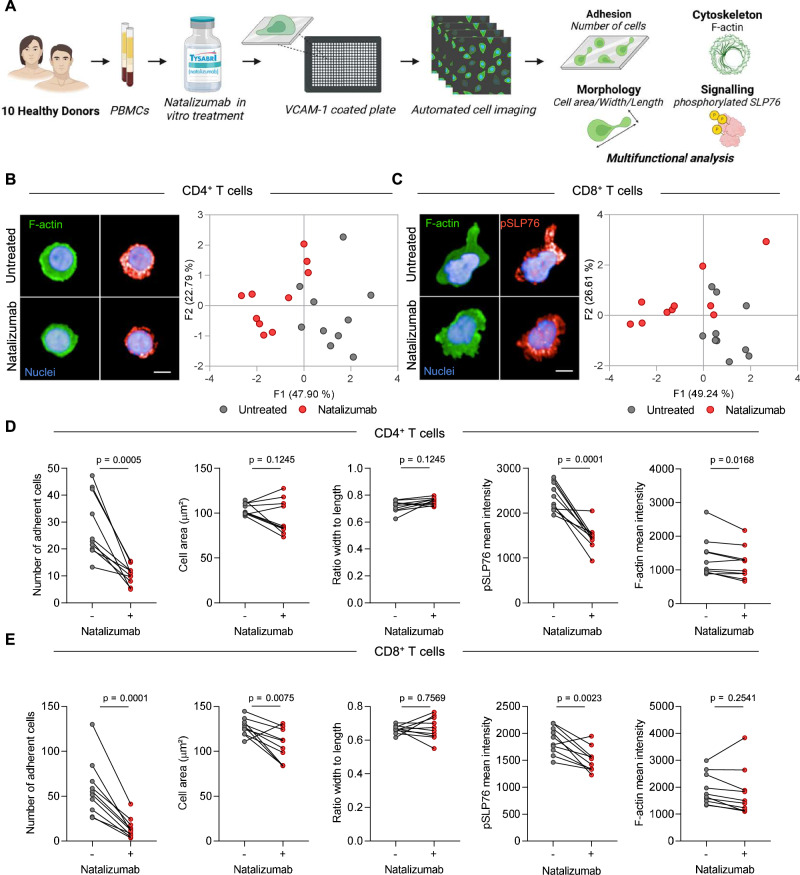In vitro morphological profiling of T cells predicts clinical response to natalizumab therapy in patients with multiple sclerosis.
Despite the efficacy of natalizumab, which targets the integrin VLA-4, in treating multiple sclerosis (MS), approximately 35% patients with MS presente evidence of disease activity two years after treatment initiation. Individual heterogeneity of leukocyte response to VLA-4 on natalizumab-mediated blockade may underlie disparities in treatment efficacy. Here we use a high-content cell imaging (HCI) pipeline to profile the in vitro effects of natalizumab on VLA-4-stimulated PBMCs from MS patients prior to natalizumab treatment. Unsupervised clustering of image data partially discriminates non-responder MS patients based on morphology, F-actin organization and signaling-related features in CD8+ T cells. Furthermore, through a random forest approach, treatment response can be predicted with a performance of 92% for a Discovery cohort and 88% for a validation cohort. Unfavorable treatment response is associated with a distinct actin remodeling response of natalizumab-exposed CD8+ T cells and a residual ability of these cells to spread on VCAM-1. Our study thus unveils that CD8+ T cells from individual MS patients display heterogeneous susceptibility to natalizumab in vitro and highlights the potential of HCI-based pretreatment monitoring to assist individualized treatment prescription.
Authors
Chaves B, Santos E Silva JC, Nakaya H, Socquet-Juglard N, et al.
External link
Publication Year
Publication Journal
Associeted Project
Network & Precision Medicine
Lista de serviços
-
Gene regulatory and signaling networks exhibit distinct topological distributions of motifs.Gene regulatory and signaling networks exhibit distinct topological distributions of motifs.
-
Gene signatures of autopsy lungs from obese patients with COVID-19.Gene signatures of autopsy lungs from obese patients with COVID-19.
-
Network Medicine: Methods and ApplicationsNetwork Medicine: Methods and Applications
-
ACE2 Expression Is Increased in the Lungs of Patients With Comorbidities Associated With Severe COVID-19.ACE2 Expression Is Increased in the Lungs of Patients With Comorbidities Associated With Severe COVID-19.
-
Drug repositioning for psychiatric and neurological disorders through a network medicine approach.Drug repositioning for psychiatric and neurological disorders through a network medicine approach.
-
Linking proteomic alterations in schizophrenia hippocampus to NMDAr hypofunction in human neurons and oligodendrocytes.Linking proteomic alterations in schizophrenia hippocampus to NMDAr hypofunction in human neurons and oligodendrocytes.
-
In-depth analysis of laboratory parameters reveals the interplay between sex, age, and systemic inflammation in individuals with COVID-19.In-depth analysis of laboratory parameters reveals the interplay between sex, age, and systemic inflammation in individuals with COVID-19.
-
The evolution of knowledge on genes associated with human diseasesThe evolution of knowledge on genes associated with human diseases
-
Network vaccinology.Network vaccinology.
-
Pyruvate kinase M2 mediates IL-17 signaling in keratinocytes driving psoriatic skin inflammationPyruvate kinase M2 mediates IL-17 signaling in keratinocytes driving psoriatic skin inflammation
-
Transcriptome analysis of six tissues obtained post-mortem from sepsis patientsTranscriptome analysis of six tissues obtained post-mortem from sepsis patients
-
Gene Signatures of Symptomatic and Asymptomatic Clinical-Immunological Profiles of Human Infection by Leishmania (L.) chagasi in Amazonian BrazilGene Signatures of Symptomatic and Asymptomatic Clinical-Immunological Profiles of Human Infection by Leishmania (L.) chagasi in Amazonian Brazil
-
In vitro morphological profiling of T cells predicts clinical response to natalizumab therapy in patients with multiple sclerosis.In vitro morphological profiling of T cells predicts clinical response to natalizumab therapy in patients with multiple sclerosis.
-
Integrative immunology identified interferome signatures in uveitis and systemic disease-associated uveitis.Integrative immunology identified interferome signatures in uveitis and systemic disease-associated uveitis.
-
Gene regulatory networks analysis for the discovery of prognostic genes in gliomas.Gene regulatory networks analysis for the discovery of prognostic genes in gliomas.
-
Revealing shared molecular drivers of brain metastases from distinct primary tumors.Revealing shared molecular drivers of brain metastases from distinct primary tumors.

